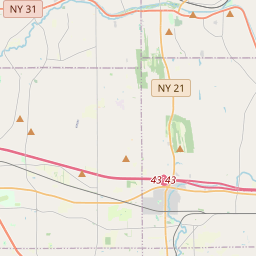Palisades
Historical marker location:
Victor, New York
( Marker can be reached from the intersection of Boughton Hill Road (County Route 41) and Victor Holcomb Road (New York State Route 444).)







© OpenStreetMap contributors
The Erie Canal, which opened in 1825 and connects the Hudson River to the Great Lakes, was originally mocked as "Clinton's Folly" after Governor DeWitt Clinton, who championed the project. However, the canal became an economic boon for New York and helped turn the state into a major commercial center.
About Ontario County
Ontario County Timeline
Ontario County, located in the western region of the state of New York, has a rich and diverse history. The area was originally inhabited by various Native American tribes, including the Seneca, Cayuga, and Onondaga. European settlement began in the late 18th century when pioneers, mainly from New England, started to establish farms and communities in the area.
In 1789, Ontario County was officially founded, named after Lake Ontario which borders its northern edge. The county's first seat was located in Canandaigua, a thriving town that quickly became a center of trade and commerce in the region. During the early 19th century, Canandaigua gained prominence as the county seat and attracted many influential figures, including political leaders and social reformers.
The region played a significant role in the women's suffrage movement in the late 19th and early 20th centuries. Susan B. Anthony, a prominent suffragist, resided in Ontario County for several years and organized influential suffrage conventions in the area. Canandaigua was also home to the Ontario County Courthouse, where the famous trial of Susan B. Anthony took place in 1873, resulting in her conviction for voting illegally.
Ontario County has experienced growth and development throughout the 20th century and into the present day. The area's diverse economy includes agriculture, manufacturing, healthcare, and tourism. Today, the county is known for its picturesque landscapes, historical sites, and attractions such as the Finger Lakes wine region, making it a popular destination for visitors and residents alike.
In 1789, Ontario County was officially founded, named after Lake Ontario which borders its northern edge. The county's first seat was located in Canandaigua, a thriving town that quickly became a center of trade and commerce in the region. During the early 19th century, Canandaigua gained prominence as the county seat and attracted many influential figures, including political leaders and social reformers.
The region played a significant role in the women's suffrage movement in the late 19th and early 20th centuries. Susan B. Anthony, a prominent suffragist, resided in Ontario County for several years and organized influential suffrage conventions in the area. Canandaigua was also home to the Ontario County Courthouse, where the famous trial of Susan B. Anthony took place in 1873, resulting in her conviction for voting illegally.
Ontario County has experienced growth and development throughout the 20th century and into the present day. The area's diverse economy includes agriculture, manufacturing, healthcare, and tourism. Today, the county is known for its picturesque landscapes, historical sites, and attractions such as the Finger Lakes wine region, making it a popular destination for visitors and residents alike.
Ontario County Timeline
This timeline provides a condensed summary of the historical journey of Ontario County, New York.
- 1789 - Ontario County is established as one of the original counties in New York State.
- 1790 - The first permanent settlement is established in Canandaigua, the current county seat.
- 1794 - Ontario County Courthouse is built in Canandaigua.
- 1802 - Rochester becomes part of Ontario County.
- 1821 - Monroe County is created, separating from Ontario County.
- 1823 - Yates County is created, further reducing the size of Ontario County.
- 1840s - The railroad arrives in Ontario County, stimulating economic growth.
- 1874 - Ontario County Courthouse burns down and is later rebuilt.
- 1900s - Ontario County becomes known for its agricultural production, particularly grape growing and winemaking.